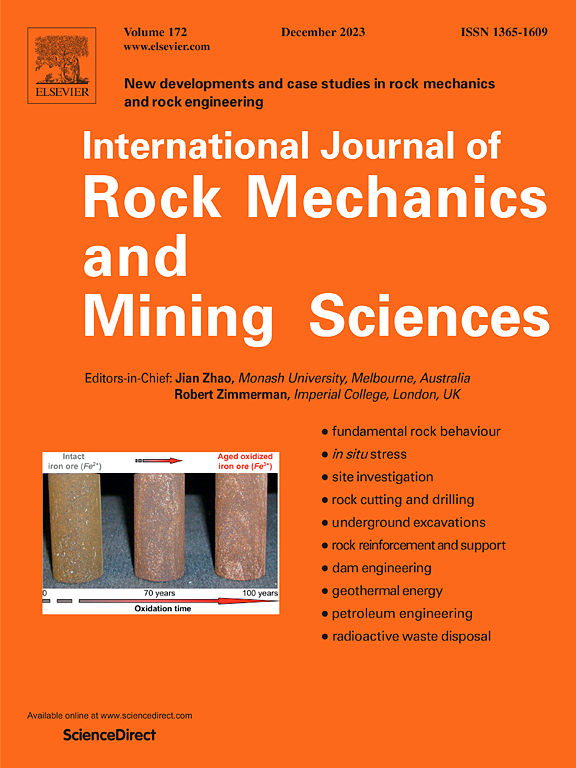标准 JRC 双层岩块剪切行为的实验和数值研究
IF 7
1区 工程技术
Q1 ENGINEERING, GEOLOGICAL
International Journal of Rock Mechanics and Mining Sciences
Pub Date : 2024-10-14
DOI:10.1016/j.ijrmms.2024.105930
引用次数: 0
摘要
多节理岩体的抗剪性能对地下工程结构的稳定性有重大影响。在这项工作中,利用三维打印技术制备了包含两个节理的岩石样品,这些节理的间距和粗糙度值各不相同,并在不同的法向应力条件下进行了直接剪切试验。结果表明,剪切应力-剪切位移曲线受接缝粗糙度系数(JRC)和法向应力的影响。峰值剪应力随 JRC 和法向应力的增加而增加,但随接头间距的增加而减小。JRC 和法向应力的增加会加剧剪应力软化。双接头样本的主要破坏模式是岩石层间断裂,接头间距对剪切破坏模式的影响小于 JRC 和法向应力。根据开发的粘聚区模型(CZM)方法,揭示了双节理样品的剪切破坏行为和微裂缝机理。数值测试表明,双连接模型中的裂缝数量随 JRC 和法向应力的增加而增加,但随连接间距的增加而减少。该模型产生的拉伸裂缝明显多于剪切裂缝,拉伸裂缝主要位于双节理模型的岩石夹层中,而剪切裂缝则集中在节理表面附近。这项研究探讨了双节理岩体的剪切力学特征和微破坏行为,为复杂多节理岩体的剪切破坏机制提供了基础性见解。本文章由计算机程序翻译,如有差异,请以英文原文为准。
Experimental and numerical study on the shear behaviour of standard JRC double-joint rock masses
The shear resistance of multi-joint rock masses significantly affects the stability of underground engineering structures. In this work, using 3D printing technology, rock-like samples containing two joints with varying joint spacings and roughness values are prepared and subjected to direct shear tests under different normal stress conditions. The results demonstrate that the shear stress-shear displacement curve is influenced by the joint roughness coefficient (JRC) and normal stress. Peak shear stress increases with increasing JRC and normal stress but decreases with increasing joint spacing. Increases in JRC and normal stress increase the shear stress softening. The primary failure mode of the double-joint samples involves rock interlayer fracturing, the joint spacing has a smaller impact on shear failure mode than the JRC and normal stress. The shear failure behaviour and microcracking mechanism of a double-joint sample are revealed based on the developed cohesive zone model (CZM) method. Numerical tests revealed that the number of cracks in the double-joint model increases with increasing JRC and normal stress but decreases with increasing joint spacing. The model results in significantly more tensile cracks than shear cracks, tensile cracks are predominantly located in the rock interlayer of the double-joint model, whereas shear cracks are concentrated near the joint surfaces. This study explores the shear mechanical characteristics and microdamage behaviour of double-joint rock masses and offers foundational insights into the shear failure mechanisms of complex multi-joint rock masses.
求助全文
通过发布文献求助,成功后即可免费获取论文全文。
去求助
来源期刊
CiteScore
14.00
自引率
5.60%
发文量
196
审稿时长
18 weeks
期刊介绍:
The International Journal of Rock Mechanics and Mining Sciences focuses on original research, new developments, site measurements, and case studies within the fields of rock mechanics and rock engineering. Serving as an international platform, it showcases high-quality papers addressing rock mechanics and the application of its principles and techniques in mining and civil engineering projects situated on or within rock masses. These projects encompass a wide range, including slopes, open-pit mines, quarries, shafts, tunnels, caverns, underground mines, metro systems, dams, hydro-electric stations, geothermal energy, petroleum engineering, and radioactive waste disposal. The journal welcomes submissions on various topics, with particular interest in theoretical advancements, analytical and numerical methods, rock testing, site investigation, and case studies.

 求助内容:
求助内容: 应助结果提醒方式:
应助结果提醒方式:


